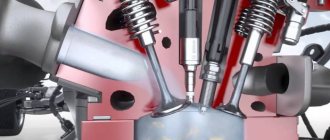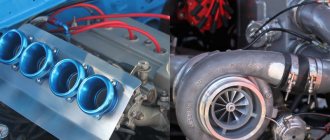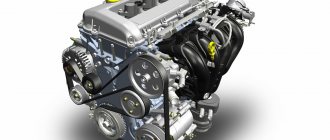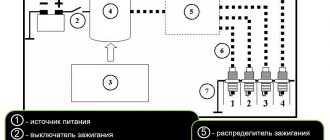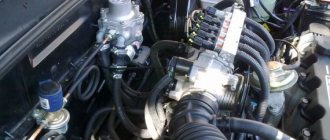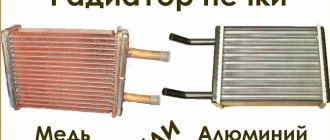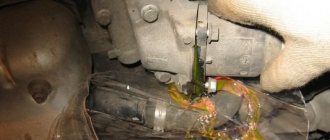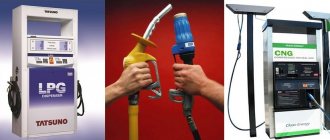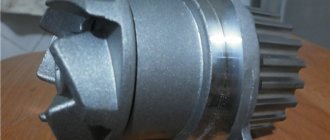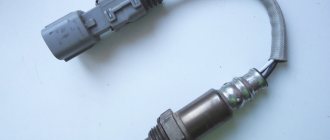Injection engines are distinguished by the absence of a carburetor, which is replaced by new fuel mixture supply systems. When you press the gas pedal, the air flow into the fuel cylinders is automatically regulated.
Gasoline solutions are monitored by a special electronic device embedded in the engine. The fuel supply in an injection engine has design features that help reduce the amount of harmful substances emitted into the atmosphere.
Single point..
Sometimes called center injection, it became widely used in passenger cars in the 1980s.
This power system got its name due to the fact that fuel was supplied to the intake manifold at only one point. Many systems of that time were purely mechanical, they did not have electronic control. Often, the basis for such a power system was a conventional carburetor, from which all “extra” elements were simply removed and one or two nozzles were installed in the area of its diffuser (therefore, central injection was relatively inexpensive). For example, this is how the TBI (“Throttle Body Injection”) system from General Motors was designed.
But, despite its apparent simplicity, central injection has a very important advantage over a carburetor - it more accurately doses the combustible mixture in all engine operating modes. This allows you to avoid failures in the operation of the motor, and also increases its power and efficiency.
Over time, the advent of electronic control units made central injection more compact and reliable. It has become easier to adapt it to work on different engines.
However, single-point injection also inherited a number of disadvantages from carburetors. For example, high resistance to air entering the intake manifold and poor distribution of the fuel mixture among individual cylinders. As a result, an engine with such a power system does not have very high performance. Therefore, today central injection is practically not found.
By the way, the General Motors concern has also developed an interesting type of central injection - CPI (“Central Port Injection”). In such a system, one nozzle sprayed fuel into special tubes that were led into the intake manifold of each cylinder. This was a kind of prototype of distributed injection. However, due to low reliability, the use of CPI was quickly abandoned.
Multipoint injection adjustment
Before considering the principle of injection adjustment, it is worth considering that each modification of the vehicle has its own subtleties of operation. Therefore, setting up the system can occur in different ways. Here's how the procedure is performed for the most common modifications.
Bosch L3.1, MP3.1
Before you start setting up such a system, you need to:
- Check the ignition condition. If necessary, worn parts are replaced with new ones;
- Make sure the throttle is working properly;
- A clean air filter is installed;
- The engine warms up (until the fan turns on).
First, the idle speed is adjusted. For this purpose, there is a special adjusting screw on the throttle. If you turn it clockwise (twists), then the XX speed indicator will decrease. Otherwise, increase.
In accordance with the manufacturer's recommendations, exhaust quality analyzers are installed on the system. Next, remove the plug from the air supply adjusting screw. By turning this element, the composition of the VTS is adjusted, which will be indicated by the exhaust gas analyzer.
Bosch ML4.1
In this case, the idle speed is not set. Instead, the device mentioned in the previous review is connected to the system. The operation of multi-point spraying is adjusted based on the state of the exhaust gases using an adjusting screw. When the hand turns the screw clockwise, the CO composition will increase. When turning in the other direction, this indicator decreases.
Bosch LU 2-Jetronic
Such a system is adjusted to the XX speed in the same way as the first modification. The mixture enrichment is adjusted using algorithms programmed into the microprocessor of the control unit. This parameter is adjusted in accordance with the pulses of the lambda probe (read more about the device and its operating principle separately).
Bosch Motronic M1.3
The idle speed in such a system is regulated only if the gas distribution mechanism has 8 valves (4 for intake, 4 for exhaust). In 16-valve engines, XX is adjusted by an electronic control unit.
The 8-valve valve is adjusted according to the same scheme as previous modifications:
- XX is adjusted with a screw on the throttle;
- A CO analyzer is connected;
- Using the adjusting screw, the composition of the military technical equipment is adjusted.
Some cars are equipped with a system such as:
- MM8P;
- Bosch Motronic5.1;
- Bosch Motronic3.2;
- Sagem-Lukas 4GJ.
In these cases, it will not be possible to adjust either the idle speed or the composition of the air-fuel mixture. The manufacturer of such modifications did not provide for this possibility. The ECU must do all the work. If the electronics were unable to adjust the injection operation correctly, it means that there are some system errors or breakdowns. They can only be identified through diagnosis. In the most difficult situations, incorrect operation of the vehicle is caused by a breakdown of the control unit.
Distributed
OR MULTI-POINT fuel injection is the most common engine power supply system on modern cars today. It differs from the previous type primarily in that there is an individual nozzle in the intake manifold of each cylinder. At certain points in time, it injects the required portion of gasoline directly into the intake valves of “its” cylinder.
Multipoint injection can be parallel or sequential. In the first case, at a certain point in time, all the injectors fire, the fuel is mixed with air, and the resulting mixture waits for the intake valves to open to enter the cylinder. In the second case, the operating period of each injector is calculated individually so that gasoline is supplied for a strictly defined time before the valve opens. The efficiency of such injection is higher, so sequential systems have become more widespread, despite the more complex and expensive electronic “stuffing”. Although sometimes there are cheaper combined schemes (in this case, the injectors fire in pairs).
At first, distributed injection systems were also controlled mechanically. But over time, electronics prevailed here too. After all, by receiving and processing signals from many sensors, the control unit not only commands the actuators, but can also signal the driver about a malfunction. Moreover, even in the event of a breakdown, the electronics switches to emergency mode, allowing the car to independently reach a service station.
Distributed injection has a number of advantages. In addition to preparing the combustible mixture of the correct composition for each engine operating mode, such a system also more accurately distributes it among the cylinders and creates minimal resistance to the air passing through the intake manifold. This allows you to improve many engine indicators: power, efficiency, environmental friendliness, etc. Among the disadvantages of multipoint injection, perhaps only the rather high cost can be mentioned.
Carrying out maintenance of power supply systems for injection engines
Activities for maintenance of power supply systems have the following features:
- During engine operation, air filters are most often subject to contamination and failure. Every thirty thousand kilometers it is necessary to replace the filter element with a new one
. It is also recommended to regularly clean the removed unit from dirt and dust using a brush and shaking. - The occurrence of jerks when the car moves indicates the need to replace the filter that finely cleans the fuel. It is also recommended to make scheduled replacements after the next 30 thousand km.
- The injectors are regularly checked and the idle air control valve is replaced.
The performance of any vehicle is, first of all, ensured by the proper operation of its “heart” - the engine. In turn, an integral part of the stable operation of this “body” is the coordinated operation of the injection system, with the help of which the fuel necessary for operation is supplied. Today, thanks to many advantages, it has completely replaced the carburetor system. The main positive aspect of its use is the presence of “smart electronics”, which ensures precise dosage of the air-fuel mixture, which increases the vehicle’s power and significantly increases fuel efficiency. In addition, the electronic injection system helps to a much greater extent to adhere to strict environmental standards, the issue of compliance with which has recently become increasingly relevant. Considering the above, the choice of topic for this article is more than appropriate, so let's look at the principle of operation of this system in more detail.
Operating principle of electronic fuel injection
An electronic (or more commonly known version of the name “injection”) fuel supply system can be installed on cars with both gasoline and petrol engines. However, the design of the mechanism in each of these cases will have significant differences. All fuel systems can be divided according to the following classification criteria:
— the method of fuel supply is divided into intermittent and continuous supply;
The type of dosing systems includes distributors, nozzles, pressure regulators, plunger pumps;
The method of controlling the amount of supplied combustible mixture is mechanical, pneumatic and electronic;
The main parameters for adjusting the mixture composition are the vacuum in the intake system, the throttle angle and air flow.
The fuel injection system of modern gasoline engines is either electronically or mechanically controlled. Naturally, an electronic system is a more advanced option, since it can provide much better fuel economy, reduce emissions of harmful toxic substances, increase engine power, improve the overall dynamics of the machine and facilitate cold starts.
The first fully electronic system was a product released by the American company Bendix
in 1950.
17 years later, Bosch created a similar device, after which it was installed on one of the Volkswagen models.
It was this event that marked the beginning of the mass distribution of the electronic fuel injection control system (EFI - Electronic Fuel Injection), not only on sports cars, but also on luxury vehicles.
The fully electronic system uses for its operation (fuel injectors), the entire activity of which is based on electromagnetic action. At certain points in the engine operating cycle, they open and remain in this position for the entire time required to supply a particular amount of fuel. That is, the open time is directly proportional to the required amount of gasoline.
Among the fully electronic fuel injection systems, the following two types are distinguished, differing mainly only in the way air flow is measured: a system with indirect air pressure measurement
and with
direct airflow measurement.
Such systems, to determine the level of vacuum in the manifold, use an appropriate sensor (MAP - manifold absolute pressure). Its signals are sent to the electronic control module (unit), where, taking into account similar signals coming from other sensors, they are processed and redirected to the electromagnetic nozzle (injector), which causes it to open for the required time for air intake.
A good representative of a system with a pressure sensor is the Bosch D-Jetronic
(letter “D” - pressure). The operation of the electronically controlled injection system is based on certain features. Now we will describe some of them, characteristic of the standard type of such a system (EFI). Let's start with the fact that it can be divided into three subsystems: the first is responsible for fuel supply, the second is for air intake, and the third is an electronic control system.
The structural parts of the fuel supply system are the fuel tank, the fuel pump, the fuel supply line (directing from the fuel distributor), the fuel injector, the fuel pressure regulator and the fuel return line. The principle of operation of the system is as follows: using an electric fuel pump (located inside or next to the fuel tank), gasoline leaves the tank and is supplied to the injector, and all contaminants are filtered out using a powerful built-in fuel filter. That part of the fuel that was not directed through the nozzle into the suction line is returned to the tank through the return fuel drive. Maintaining constant fuel pressure is ensured by a special regulator responsible for the stability of this process.
The air intake system consists of a throttle valve, an intake manifold, an air purifier, an intake valve and an air intake chamber. The principle of its operation is as follows: with the throttle valve open, air flows pass through the purifier, then through the air flow meter (L-type systems are equipped with it), the throttle valve and a well-tuned intake pipe, after which they enter the intake valve. The function of directing air into the engine requires an actuator. As the throttle valve opens, a significantly larger amount of air enters the engine cylinders.
Some powertrains use two different methods to measure the volume of incoming air flow. So, for example, when using an EFI system (type D), the air flow is measured by monitoring the pressure in the suction manifold, that is, indirectly, while a similar system, but already type L, does this directly, using a special device - an air flow meter.
The electronic control system includes the following types of sensors:
engine, electronic control unit (ECU), fuel injector device and associated wiring.
Using the specified unit, by monitoring the sensors of the power unit, the exact amount of fuel supplied to the injector is determined.
In order to supply air/fuel to the engine in appropriate proportions, the control unit starts the operation of the injectors for a specific period of time, which is called the “injection pulse width” or “injection duration”. If we describe the main operating mode of the electronic fuel injection system, taking into account the already mentioned subsystems, it will have the following form. Entering the power unit through the air intake system, air flows are measured using a flow meter. When air enters the cylinder, it mixes with fuel, in which the operation of the fuel injectors (located behind each intake valve of the intake manifold) plays an important role. These parts are a kind of electrovalves that are controlled by an electronic unit (ECU). It sends certain pulses to the injector using its grounding circuit on and off. When it is turned on, it opens and sprays fuel onto the rear wall of the intake valve. When it enters the outside air, it mixes with it and evaporates due to the low pressure of the suction manifold.
The signals sent by the electronic control unit ensure that the fuel supply level is sufficient to achieve the ideal air/fuel ratio (14.7:1), also called stoichiometry.
It is the ECU, based on the measured air volume and engine speed, that determines the main injection volume. Depending on the operating conditions of the engine, this indicator may vary. The control unit monitors such variable values as engine speed, antifreeze (coolant) temperature, oxygen content in the exhaust gases and throttle angle, according to which it makes injection adjustments that determine the final volume of injected fuel.
Of course, a power system with electronic fuel dosing is superior to carburetor power supply for gasoline engines, so there is nothing surprising in its wide popularity. Gasoline injection systems, due to the presence of a huge number of electronic and moving precision elements, are more complex mechanisms and therefore require a high level of responsibility in approaching the issue of maintenance.
The existence of an injection system makes it possible to more accurately distribute fuel among the engine cylinders. This became possible due to the absence of additional resistance to the air flow, which was created by the carburetor and diffusers at the inlet. Accordingly, an increase in the cylinder filling ratio directly affects an increase in the engine power level. Let's now take a closer look at all the positive aspects of using an electronic fuel injection system.
Pros and cons of electronic fuel injection
The positive points include:
Possibility of more uniform distribution of the fuel-air mixture.
Each cylinder has its own injector, delivering fuel directly to the intake valve, eliminating the need for supply through the intake manifold. This helps to improve its distribution between the cylinders.
High-precision control of air and fuel proportions, regardless of engine operating conditions.
Using a standard electronic system, a precise proportion of fuel and air is supplied to the engine, which significantly improves the vehicle's drivability, fuel efficiency and emission control. Improved throttle performance. By supplying fuel directly to the rear wall of the intake valve, the operation of the intake manifold can be optimized, thereby increasing the speed of air flow through the intake valve. Due to such actions, the torque and operating efficiency of the throttle are improved.
Increased fuel efficiency and improved emissions control.
In engines equipped with an EFI system, richer fuel mixtures during cold starts and wide open throttle can be reduced since fuel mixing is not a problem. Due to this, it becomes possible to save fuel and improve control of exhaust gases.
Improving the performance of a cold engine (including starting performance).
The ability to inject fuel directly onto the intake valve, combined with an improved atomization formula, correspondingly improves the starting and operating capabilities of a cold engine. Simplification of mechanics and reduction of sensitivity to adjustment. During a cold start or fuel sensing, the EFI system is independent of the fuel richness adjustment. And since, from a mechanical point of view, it is simple, its maintenance requirements are reduced.
However, no mechanism can have exclusively positive qualities, therefore, in comparison with the same carburetor engines, engines with an electronic fuel injection system have some disadvantages. The main ones include: high cost; almost complete impossibility of repair actions; high requirements for fuel composition; strong dependence on power sources and the need for constant voltage (a more modern option, which is controlled electronically). Also, in the event of a breakdown, it will not be possible to do without specialized equipment and highly qualified personnel, which results in too expensive maintenance.
Diagnosis of the causes of malfunctions in the electronic fuel injection system
The occurrence of problems in the injection system is not such a rare occurrence. This issue is especially relevant for owners of older car models, who have more than once had to deal with both ordinary clogging of injectors and more serious problems with electronics. There can be many reasons for malfunctions that often occur in this system, but the most common among them are the following:
— defects (“defects”) of structural elements;
Limit service life of parts;
Systematic violation of vehicle operating rules (use of low-quality fuel, system contamination, etc.);
External negative influences on structural elements (moisture ingress, mechanical damage, oxidation of contacts, etc.)
The most reliable way to determine them is computer diagnostics. This type of diagnostic procedure is based on the automatic recording of deviations of system parameters from the established normal values (self-diagnosis mode). Detected errors (inconsistencies) remain in the memory of the electronic control unit in the form of so-called “fault codes”. To carry out this research method, a special device (a personal computer with a program and a cable or a scanner) is connected to the diagnostic connector of the unit, the task of which is to read all existing fault codes. However, keep in mind that in addition to special equipment, the accuracy of the results of computer diagnostics will depend on the knowledge and skills of the person who performed it.
Therefore, the procedure should be trusted only to qualified employees of special service centers.
The computer check of the electronic components of the injection system includes
T:
— fuel pressure diagnostics;
Checking all mechanisms and components of the ignition system (module, high-voltage wires, spark plugs);
Checking the tightness of the intake manifold;
Composition of the fuel mixture; assessment of toxicity of exhaust gases on the CH and CO scales);
Diagnostics of signals of each sensor (the method of reference oscillograms is used);
Checking cylindrical compression; monitoring timing belt position marks and many other functions that depend on the car model and the capabilities of the diagnostic device itself.
Carrying out this procedure is necessary if you want to find out whether there are any malfunctions in the electronic fuel supply (injection) system and, if so, what they are. The EFI electronic unit (computer) “remembers” all faults only while the system is connected to the battery; if the terminal is disconnected, all information will disappear. This will happen exactly until the driver turns on the ignition again and the computer again checks the functionality of the entire system.
On some vehicles equipped with an Electronic Fuel Injection (EFI) system, there is a box under the hood with the words “DIAGNOSIS”
.
There is also a rather thick bundle of various wires connected to it. If you open the box, the pin markings will be visible on the inside of the cover. Take any wire and use it to close terminals “E1”
and
“TE1”
, then get behind the wheel, turn on the ignition and watch the reaction of the “CHECK” light (it shows the engine).
Note! The air conditioner must be turned off.
As soon as you turn the key in the ignition, the indicated light will begin to flash. If it “blinks” 11 times (or more), after an equal period of time, this will mean that there is no information in the memory of the on-board computer and a trip to a full diagnosis of the system (in particular, electronic fuel injection) can be postponed. If the outbreaks differ in any way, then you should contact a specialist.
This method of “home” mini-diagnosis is not available to all vehicle owners (mostly only foreign cars), but those who have such a connector are lucky in this regard.
Subscribe to our feeds at
Fuel injection is a system for metering fuel into the engine cylinders. Let's talk about electronic fuel supply systems
, how they work and what sensors they consist of.
How does the fuel injection system work?
The figure schematically shows the principle of operation of distributed injection.
The air supply (2) is regulated by the throttle valve (3) and is accumulated in the receiver (4) before being divided into 4 streams. The receiver is necessary for the correct measurement of mass air flow (since the total mass flow or pressure in the receiver is measured.
The latter must be of sufficient volume to prevent air “starvation” of the cylinders with high air consumption and smooth out pulsations at start-up. The injectors (5) are installed in the channel in close proximity to the intake valves.
Crankshaft position sensor (CPS)
— reads the crankshaft rotation speed and its position. Serves for general synchronization of the system, calculation of engine speed and crankshaft position at certain points in time. DPKV - polar sensor. If turned on incorrectly, the engine will not start. If the sensor fails, the system cannot operate. This is the only “vital” sensor in the system that makes it impossible for the vehicle to move. Failures of all other sensors allow you to get to the service center on your own.
Mass air flow sensor (MAF)
— determines the mass flow of air entering the engine. Serves to calculate the cyclic filling of cylinders. The air mass flow is measured, which is then recalculated by the program into cylinder cyclic filling. If a sensor fails, its readings are ignored and calculations are made using emergency tables.
Coolant temperature sensor (DTOZH)
- monitors the coolant temperature. Serves to determine fuel supply and ignition temperature correction and control the electric fan. If the sensor fails, its readings are ignored, the temperature is taken from the table depending on the engine operating time. The DTOZh signal is supplied only to the electronic control unit; another sensor is used for indication on the panel.
Throttle Position Sensor (TPS)
— determines the throttle position (whether the gas pedal is pressed or not). Serves to calculate the load factor on the engine and its change depending on the throttle opening angle, engine speed and cyclic filling.
Knock sensor
- Serves to control engine detonation. When the latter is detected, the engine control unit turns on the detonation damping algorithm, quickly adjusting the ignition timing. The first injection systems used a resonant knock sensor that came from a GM system. Wideband sensors are now widely used.
Speed sensor (DS)
— determination of vehicle speed. Used when calculating blocking/resuming fuel supply while driving. This signal is also sent to the dashboard to calculate mileage. 6000 signals from the DS approximately correspond to 1 km. vehicle mileage.
Phase sensor (PF)
— determines the position of the camshaft. Serves for precise synchronization of injection timing in systems with phased (sequential) injection. In case of an accident or absence of a sensor, the system switches to a pairwise - parallel (group) fuel supply system.
Rough road sensor
— serves to assess the level of engine vibration. This is necessary for the correct operation of the misfire detection system in order to determine the cause of the unevenness (used in connection with the introduction of Euro-3 toxicity standards).
Ignition module
— electronic spark control device. Contains two independent channels for igniting the mixture in the cylinders. In the latest modifications, the low-voltage elements of the ignition module are placed in the electronic control unit, and to obtain high voltage, either a remote two-channel ignition coil or ignition coils directly on the spark plug are used.
Idle speed control
- serves to maintain the specified idle speed. It is a stepper motor that regulates the air bypass in the throttle body to provide the engine with the air needed to maintain idle speed when the throttle valve is closed.
Cooling fan
— controlled by the electronic control unit based on signals from the coolant temperature sensor. The difference between on/off is usually 4-5°C.
Fuel consumption signal
— issued to the trip computer — 16,000 pulses per 1 calculated liter of fuel consumed. These data are approximate, because they are calculated on the basis of the total opening time of the injectors, taking into account a certain empirical coefficient, which is necessary to compensate for measurement errors caused by the operation of the injectors in the non-linear part of the range, asynchronous fuel supply and other factors.
Adsorber
— is an element of a closed chain for recycling gasoline vapors. Euro-2 standards do not provide for contact of the gas tank ventilation with the atmosphere; gasoline vapors must be collected (adsorbed) and, when purged, sent to the cylinders for afterburning.
Read more in the article: “What is an adsorber? "
Electronic control unit
An electronic control unit
is a specialized microcomputer that processes data coming from sensors and controls actuators according to a certain algorithm.
The program itself is stored in a ROM chip, the English name of the chip is CHIP. The contents of the “chip” are usually divided into two functional parts - the program itself, which performs data processing and mathematical calculations, and the calibration block. Calibrations are a set (array) of fixed data (variables) for the operation of the control program.
It should be borne in mind that for proper operation of the injection system, it is necessary to have working sensors
and actuators.
Direct..
The Goliath GP700 was the first production car to feature fuel injection.
INJECTION (also sometimes called direct) differs from previous types of power systems in that in this case the injectors supply fuel directly to the cylinders (bypassing the intake manifold), like a diesel engine.
In principle, this power system design is not new. Back in the first half of the last century, it was used on aircraft engines (for example, on the Soviet La-7 fighter). In passenger cars, direct injection appeared a little later - in the 50s of the twentieth century, first on the Goliath GP700 car, and then on the famous Mercedes-Benz 300SL. However, after some time, automakers practically abandoned the use of direct injection; it remained only on racing cars.
The fact is that the cylinder head of a direct injection engine was very complex and expensive to manufacture. In addition, for a long time the designers were unable to achieve stable operation of the system. Indeed, for effective mixture formation during direct injection, it is necessary that the fuel is well atomized. That is, it was supplied to the cylinders under high pressure. And this required special pumps capable of providing it. As a result, at first, engines with such a power system turned out to be expensive and uneconomical.
What does injection sequence mean?
The sequence or phases of fuel injection are determined by the following indicators:
- During one engine cycle, each special injector performs one injection phase;
- The time of this phase may be different for each car model, but in most cases the amount of fuel is the same.
Multiport fuel injection is not implemented on every car, since it differs in that it is only suitable for injection cars. Car owners who encounter this system note that it allows them to achieve up to 15% fuel savings.
Direct fuel injection - good or bad?
Direct injection engines (also called direct injection, or GDI) have only recently started appearing in cars. However, the technology is gaining popularity and is increasingly found on the engines of new cars. Today we will try to answer in general terms what direct injection technology is and should we be afraid of it?
To begin with, it is worth noting that the main distinguishing feature of the technology is the location of the injectors, which are located directly in the cylinder head, respectively, and injection under enormous pressure occurs directly into the cylinders, in contrast to the fuel injection system into the intake manifold, which has long proven itself to be the best.
Direct injection was first tested in mass production by the Japanese automaker Mitsubishi. Operation showed that among the advantages, the main advantages were efficiency - from 10% to 20%, power - plus 5% and environmental friendliness. The main disadvantage is that injectors are extremely demanding on fuel quality.
It is also worth noting that a similar system has been successfully installed on diesel engines for many decades. However, it was on gasoline engines that the use of technology was associated with a number of difficulties that have not yet been completely resolved.
A video from the Savagegeese YouTube channel explains what direct injection is and what can go wrong when operating a car with this system. In addition to the main pros and cons, the video also explains the ins and outs of preventative system maintenance. In addition, the video touches on the topic of intake duct injection systems, which can be seen in abundance on older engines, as well as engines that use both methods of fuel injection. Using Bosch diagrams clearly, the presenter explains how it all works.
To find out all the nuances, we suggest watching the video below (turning on the subtitle translation will help you figure it out if you don’t know English very well). For those who are not too interested in watching, you can read about the main pros and cons of direct gasoline injection below, after the video:
So, environmental friendliness and efficiency are good goals, but here are the risks of using modern technology in your car:
Checking multi-point injection
A violation of the gasoline supply circuit occurs due to the failure of one of the elements. Here are the symptoms that can be used to recognize a malfunction of the injection system:
- The engine starts with great difficulty. In more critical situations, the engine does not start at all.
- Unstable operation of the power unit, especially at idle.
It is worth paying attention to the fact that these “symptoms” are not characteristic exclusively of the injector. Similar problems occur in the event of problems with the ignition system. Computer diagnostics usually helps in such situations. This procedure allows you to quickly identify the source of failure that is causing multipoint injection to be ineffective.
In most cases, the specialist simply resets errors that prevent the control unit from correctly adjusting the operation of the power unit. If computer diagnostics show a breakdown or incorrect operation of the spray mechanisms, then before you begin searching for the failed element, it is necessary to eliminate the high pressure in the line. To do this, simply disconnect the negative terminal of the battery and loosen the fastening nut in the line.
There is another way to reduce the pressure in the main line. To do this, disconnect the fuel pump fuse. Then the engine starts and runs until it stalls. In this case, the unit itself will generate the pressure of the fuel located in the ramp. At the end of the procedure, the fuse is installed in its place.
The system itself is checked in the following sequence:
- A visual inspection of the electrical wiring is carried out to see if there is oxidation on the contacts or damage to the cable insulation. Due to such malfunctions, power may not be supplied to the actuators, and the system either stops working or becomes unstable.
- The condition of the air filter plays an important role in the operation of the fuel system, so it is important to check it.
- Spark plugs are checked. By the deposits on their electrodes, you can recognize hidden problems (read about this in detail separately) of the systems on which the operation of the power unit depends.
- The compression in the cylinders is checked. Even if the fuel system is working properly, with low compression the engine will be less dynamic. There is a separate review on how this parameter is checked.
- In parallel with vehicle diagnostics, you need to check the ignition, namely, whether the OZ is set correctly.
After the problems with the injection have been corrected, it needs to be adjusted. Here's how the procedure is performed.
How does direct injection work and is it any good?
There are enough praises for direct injection in promotional materials. And we will try to speak relatively impartially.
What is direct injection
This is a fuel system device in which gasoline is injected directly into the cylinder by an injector. This differs from “ordinary” injection - when the nozzle injects fuel into the intake manifold.
It is perhaps too late to call this system innovative - it was implemented on many aircraft during the Great Patriotic War. For example, it was used on the La-5FN fighter.
But in cars it became relatively widespread already at the end of the twentieth and beginning of the twenty-first century, approximately with the advent of electronic engine control. It was primarily Mitsubishi with a system they called GDI. Then other Japanese brands followed them - for example, you can call Toyota with a D-4 engine. Then all this somehow calmed down, and now the banner of direct injection, which began to fall, was picked up by the VAG concern, so much so that many other automakers rush along this narrow path between saving on fuel and saving on the cost of engine components.
Why was all this started?
No matter how the internal engineer inside any employee of a car company seethes and rages, the development of most of the systems that we see in modern cars was not caused by the desire to make the most high-tech product. No, as a rule, the impetus for all innovations in systems that control the formation of a mixture is environmental standards. With a broad stroke of the pen, regulators are introducing new regulations. After this (and usually a little earlier), automakers introduce new systems that allow them to meet these standards.
It is difficult for us now to judge what motivation Mitsubishi had, but based on general trends, at least it is very similar.
The main feature (“killer features”, to use slang from another professional field) of GDI technology was the ability to work on ultra-lean mixtures. Here we immediately need to make a retreat and consider the normal operating mode of the engine.
During the intake stroke, the piston in the cylinder goes down, the intake valve opens, and the injector “sprays” fuel. A portion of fuel along with air is sucked into the cylinder by the vacuum created. Along the way, due to turbulence and similar effects, the fuel is mixed with air, and continues to do so during the compression stroke, when the intake valve is closed and the cylinder goes up. Thus, by the time the top dead center is reached, a uniform mixture is compressed in the cylinder. Moreover, the amount of fuel injected by the nozzle is calculated so that its ratio to air is 1:14.7 (or slightly leaner/richer depending on the required engine operating mode) - this mixture is called stoichiometric, and burns best.
Homogeneous mixture formation
Everything is a little simpler here; fuel injection occurs almost simultaneously with air intake. All this is done on the intake stroke, that is, when the intake valve is open and the piston goes down. While the piston makes its way down and back up, the mixture of air and gasoline will have time to mix.
Since the fuel is still injected under high pressure, mixture formation is improved, and this allows the use of more air. Therefore, the use of turbochargers and superchargers is available for such engines. Read here about the main injector malfunctions.
Features of the multi-point mechanism
The injection system is used by almost all car manufacturers.
Each nozzle is controlled individually. The time when this happens is set by the management block program. If they are activated, they are replaced by a parallel start.
As the engine warms up, the system can demonstrate proper performance at higher speeds. A breakdown of the sensor sometimes causes the device to go into full emergency mode; its readings are taken into account by the control unit in the process of determining the liquid dosage. Today, such a mechanism is controlled by a special computer called an electronic control unit. To calculate the required opening moment of the injectors, it is important to obtain information data from the sensors. An important indicator is the volume of flows that enter the engine and are measured by the sensor.
In the process of calculating the supply of a certain amount of fuel, which is necessary for the uninterrupted operation of the unit, the computer analyzes other information - these are temperature and humidity conditions, a set of other parameters.
Advantages and disadvantages
Here, as in any system, there are advantages and disadvantages.
Advantages of injectors (when compared with a carburetor):
- reduction in fuel consumption by 2 times;
- increase in power;
- simplified (automated) launch;
- easy controls;
- reducing the release of toxins several times;
- self-tuning, simplifying maintenance;
- repairs come down to replacing parts;
- lowering the hood height by placing injection elements on the sides of the engine;
- independence from atmospheric pressure and vehicle position (the operation of carburetors is disrupted during rolls).
Disadvantages of injection systems:
- relatively high production price;
- high requirements for gasoline quality;
- the need for special equipment for diagnostics;
- dependence on electricity;
- increased likelihood of fire in an accident due to the supply of gasoline under pressure.
The last drawback is partially compensated by installing a controller that turns off the feed upon impact.
Several types of injection systems made it possible to equip most passenger cars produced after the eighties with them. The control is mechanical or electronic, fuel can be supplied continuously or in pulses.
Regardless of the structure and operating principle of the fuel injection system, it will last longer without repair if you refuse to manipulate the power supply, do not unnecessarily disconnect the mass, and do not start by towing. Injection systems do not tolerate moisture; if water penetrates them in winter, there is a high probability of injector failure. The fuel must be clean, special attention should be paid to the condition of the filter installed in front of the pump. If there are impurities in the fuel, the pump and control system will very soon fail.
